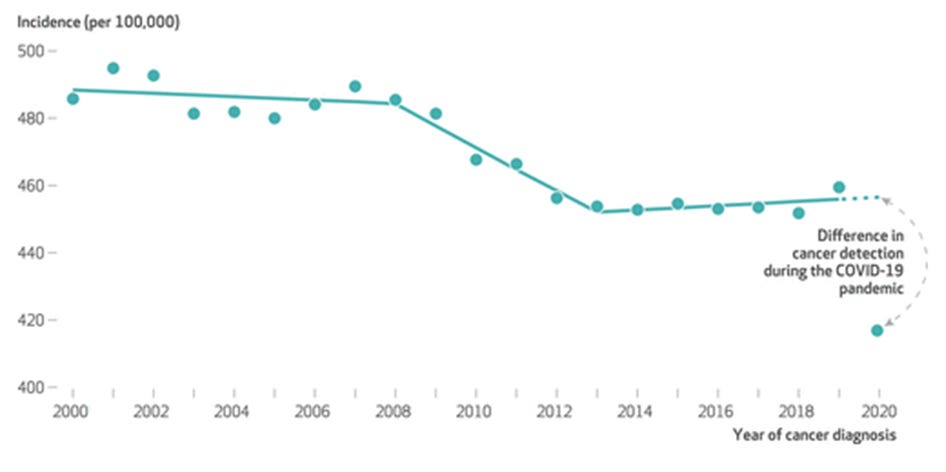New statistics on decline in cancer diagnosis during the pandemic
February 14, 2024
Trend in US cancer incidence across all cancer sites, 2000-2020
Source: Kim, et al, Health Affairs January 2024 LINK
We know that people missed many cancer screening tests during the pandemic - and we should expect higher rates of diagnosis of cancer with distant spread that is less treatable in coming years. Some early reports confirm the increase in diagnosis of later stage cancer. Researchers reviewed data from the Surveillance, Epidemiology, and End Results (SEER) program of the National Cancer Institute to quantify just how much cancer we didn’t diagnose. They published their report in Health Affairs last month.
New diagnoses fell by 8.7% across all cancer sites, and the decline was worse for Black people (-10.1%) and Hispanic people (-9.7%) and Asian and Pacific Islanders (-12.0%) compared to White people (-8.4%). Minoritized populations historically have higher rates of death from many types of cancer and this decrease in detection in the first year of the pandemic could widen this gap.
Below, you can see there is a larger decline in local breast cancer, and a smaller decline in detection of breast cancer that had already spread. This likely means an increase in diagnosis of more advanced cases of breast cancer in following years.
Source: Kim, et al, Health Affairs January 2024 LINK
Implications for Employers:
Decreased screening and detection of cancers during the pandemic will likely increase health care disparities. Communications about the importance of cancer screening should be accessible to all plan members.
Catching up on breast, colon, cervical and lung cancer screening of all populations can decrease premature deaths, although cancer screening tests are cost effective and not cost-saving. That is to say these screening tests improve quality and quantity of life at a reasonable cost.
The decrease of evidence-based screening during the pandemic lowered medical costs during that period and will raise medical costs in the future.
Employers can require their carriers to report these screenings in a standardized method that aligns with national HEDIS reportingl, which would allow employers to truly benchmark their preventive care screenings.
Employers can compare these national benchmarks to performance guarantees offered by carriers.
Thanks for reading. You can find previous posts in the Employer Coverage archive
Please “like” and suggest this newsletter to friends and colleagues. Thanks!
Tomorrow: Narcan can save lives, and out-of-pocket costs are declining


